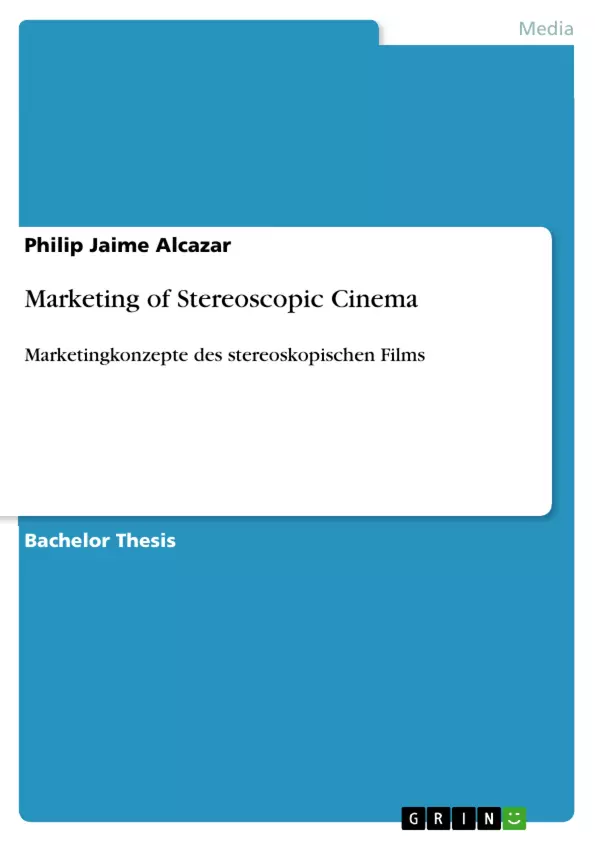With the rise of Internet platforms providing both legal and illegal file sharing utilities, media companies – especially the ones focusing theatrical cinema markets – are facing new problems and difficulties to remain merchantable in opposition with their online competition.
With the beginning of the new century, the number of sales, as to say the worldwide number of cinema attendances, experienced an ongoing stagnation or even a decrease. In order to cope with this challenge, international film production companies and cinema chains are challenged to develop new strategies if they mean to endeavor market changes.
One possibility to attract a larger audience to the cinemas could be the usage of stereoscopic 3D technology, due to the lack of an online substitute. This phenomenon is not new. When, in the 1950s, television started to become part of the average households and cinema attendance numbers collapsed, 3D films experienced a heyday.
The task of this research is to compare the former boom with today's trend and to evaluate whether the stereoscopic technology is a proper tool to enhance sales in terms of cinema attendance for international media companies.
Inhaltsverzeichnis (Table of Contents)
- Introduction
- Background information
- Problem Statement
- Research question
- Methodology and structure
- Historical Overview
- The Concept and Origins of Stereoscopy
- The Discovery of the Stereoscopic Effect
- Dissemination of Stereoscopy Through 3D Photography
- The Development of Stereoscopic Cinema
- 3D Cinema on the Rise
- Natural Vision
- Bwana Devil Points the Way
- The Golden Age - 3D's First Economic Boom
- Four Years of Economic Exploitation
- The Decline of Stereoscopy
- The Concept and Origins of Stereoscopy
- Today's Trends
- The Current Renaissance
- The Influence of Digital 3D on the Market Structure
- Digital 3D as Leverage to Digitize Distribution
- 3D Television
- The Commonalities and Differences between The Golden Age and the Current Renaissance
- Competition through Substitute Products
- Successful Ignition
- Distributional Challenges
- Quality Differences
- Persistance of Stereoscopy
- International Marketing Strategy for the Usage of 3D Films
- The Exploitation Windows
- Incorporation of Stereoscopy in the Marketing Instruments
- The 4 Ps of the International Movie Marketing Mix
- Standardization Versus Adaptation
Zielsetzung und Themenschwerpunkte (Objectives and Key Themes)
This bachelor thesis aims to assess whether stereoscopic cinema is an effective tool for increasing profitability in the international film market and to explore how it should be integrated into media companies' marketing strategies. The research delves into the historical evolution of 3D cinema, comparing the boom of the 1950s with the current renaissance, and analyzes the potential of stereoscopic technology to attract audiences in the digital age. The thesis further examines the adaptation of marketing strategies for 3D films, considering their specific characteristics and market challenges.- Historical development of stereoscopic cinema
- The impact of digital technology on the 3D film market
- The effectiveness of stereoscopic cinema in attracting audiences
- Marketing strategies for 3D films
- The integration of stereoscopic technology in the marketing mix
Zusammenfassung der Kapitel (Chapter Summaries)
The first chapter introduces the research topic and problem statement, highlighting the decline in cinema attendance and the rise of online media competition. It establishes the research question, investigating the potential of stereoscopic cinema to increase profitability and its impact on international media companies' marketing strategies. The second chapter delves into the historical overview of stereoscopic cinema, tracing its origins and evolution from early 3D photography to the development of 3D films. It analyzes the "golden age" of 3D cinema in the 1950s, exploring its economic impact and eventual decline. The third chapter explores contemporary trends in 3D cinema, discussing the current renaissance and the influence of digital technology on the market. It examines the similarities and differences between the golden age and the current era, highlighting the challenges and opportunities presented by digital distribution and competition from alternative entertainment formats.Schlüsselwörter (Keywords)
This bachelor thesis focuses on the intersection of marketing and technology, investigating the role of stereoscopic cinema as a tool to enhance profitability in the international film industry. It analyzes historical trends, the impact of digital technology on the 3D film market, and the development of marketing strategies specific to stereoscopic films. Key themes include stereoscopic cinema, marketing strategies, digital technology, film industry, international media companies, audience engagement, and profitability.- Quote paper
- Philip Jaime Alcazar (Author), 2012, Marketing of Stereoscopic Cinema, Munich, GRIN Verlag, https://www.grin.com/document/210841



